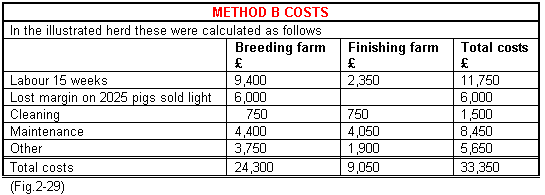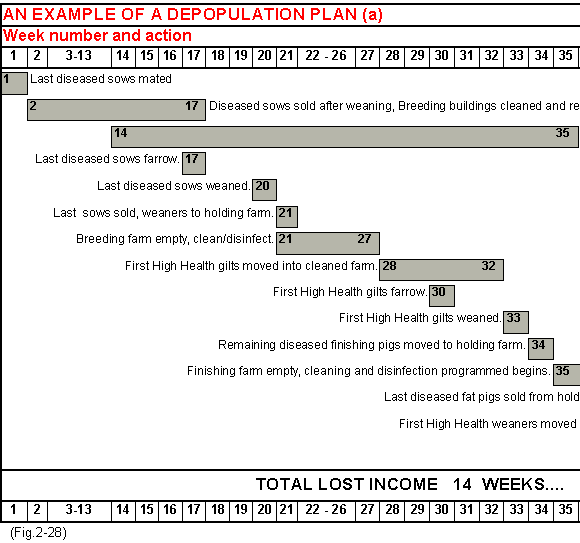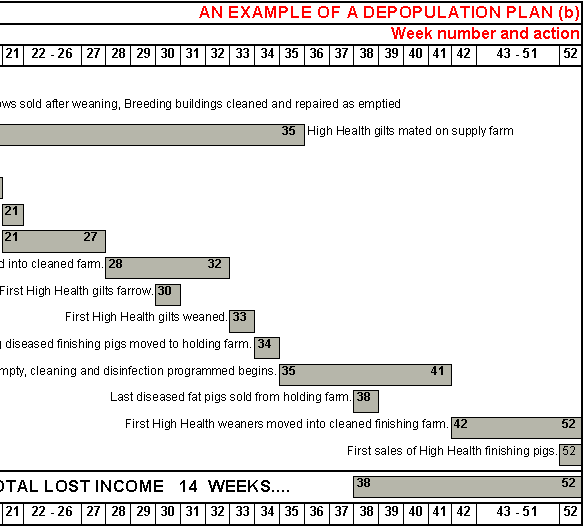



Depopulation and repopulation
The major costs of establishing a high health herd by depopulation and repopulation are related to the loss in cash flow and ongoing overhead costs between removing the old herd and its sale of pigs and the first pig sold at slaughter from the new one. In basic terms, the margin over feed per week represents the approximate costs of depopulation (building/maintenance costs need to be budgeted for). The farm must be emptied for a minimum of 4-6 weeks (8 weeks if swine dysentery exists in the farm) and further time lost will depend upon the date of commencement of the mating programme for the new incoming herd. Depopulation can be carried out in one of two ways:
- by complete removal of the herd at a fixed point in time, or
- gradual removal towards a predetermined date.
Repopulation of the herd can be carried out with maiden or pregnant gilts that are up to two weeks from farrowing.
The most cost effective method is to remove the existing weaned and growing pigs to a totally separate well isolated site where their production can be completed. The donor herd should ideally have facilities to commence the new gilt mating programme and hold these to within two weeks of farrowing. Alternatively the pregnant gilts 21 days post-service could be moved to a holding site.
Fig.2-28 (at bottom of page) illustrates the actual programme used in the depopulation and repopulation of a 350 sow herd by method B. The breeding farm producing 30kg weaners was a separate site 5km away from the finishing farm. The new gilts were mated on the supply farm and then moved to a holding farm when they were 6 weeks in pig where they remained until 2 weeks prior to farrowing. The complete gilt herd of both maiden and pregnant animals was then moved into the depopulated farm over a period of 4-6 weeks.
The decision to use either method A or B is a complex one and it is dictated by such factors as the current economics of the pig industry, the levels and costs of disease, the availability of maiden or pregnant gilts, the type of herd and the availability of holding accommodation.
For the combined breeding and finishing farm planning will be different and the decisions will depend upon:
- The age / weight of the youngest pigs to be sold and the point of depopulation e.g. 30kg liveweight.
- The date of the last farrowing to produce 30kg pigs.
- The date on which the last disease sows are mated.
- The date when the new gilt mating programme commences. This will depend on whether the programme starts on the supply farm a holding farm or the repopulated farm.
The following scenarios then exist:
It can be seen that method B as illustrated is by far the most cost effective (Fig.2-29) but equally the most complex. Method A can be improved further by selling diseased sows up to 6 weeks in pig and weaners at an earlier age.

Depopulation, repopulation costs
These represent 14 weeks of loss on a 350 sow herd - probably the very best that can be achieved. As a guide field experiences give approximate costs of £40,000 to £50,000 per 100 sows in a combined breeding finishing farm using the worst case scenario. To set against this however improvements of up to 0.4 in feed efficiency, 100g daily gain and significant reductions in mortality and medicinal costs should be achieved in the new herd. The repopulation would also allow the most updated genetics to be used to further obvious advantage.
If the finishing accommodation on a combined breeding finishing unit can be used for multi suckling then increasing the gilt mating programme and therefore the numbers of gilts farrowing is a very valuable procedure to consider. There are always a number of gilts which have to be culled after first weaning and this can also help reduce the herd to its proper size without the purchase of replacements in large batches. Farrowing a surplus number of gilts first time round costs more up front but gives a quicker return on cash flow.
Cleaning an existing pig farm is a no mean undertaking and you should be aware of the hard work that is involved. Furthermore, considerable expense will be involved in refurbishing the farm since many maintenance requirements are not evident until the buildings are empty. It is also an opportunity for major alterations.
In carrying out the cleaning and disinfection procedures efforts should be made to remove all faeces and manure from the farm. Slurry channels should be emptied and washed down and a visual and bacteriological check carried out once cleaning and disinfection has been completed.
It is vitally important that rats and mice are completely removed from the farm. Once all the houses have been cleaned then each in rotation should be sealed and fumigated with formaldehyde gas, or sprayed with a suitable disinfectant such as Virkon S. Dead pig pits should be covered with lime and finally buried.
Provided the farm is left empty for a period of 6-8 weeks few of the important disease organisms will survive except for SVD, CSF, ASF and salmonella.
Over the years clean herds have been established successfully by depopulation and repopulation for the following diseases.
- App.
- AR.
- Aujeszky's disease.
- EP.
- Foot-and-mouth disease.
- Mange.
- Salmonellosis.
- Swine fever.
- Streptococcal meningitis.
- Swine dysentery.
- Swine vesicular disease.
- TGE
Enzootic pneumonia and PRRS have however proved to be the most difficult diseases to keep out. The purchased pig has been the main cause of reinfection.









